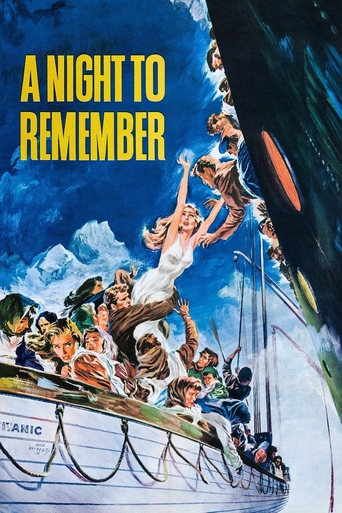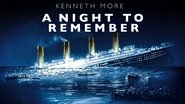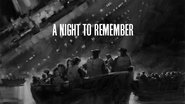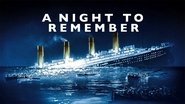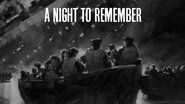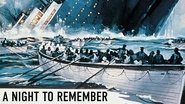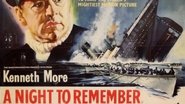wendyluhardy
I've been interested in the Titanic for many years and saw this English movie many years ago on TV. It's not one of those movies that is shown very often. Fortunately it's on YouTube (after so many movies have been taken off), so feel free to indulge.There have been many movies made about the Titanic--both for theaters and television--and while I do like James Cameron's 1997 version, "A Night to Remember" is the better film. Made only 45 years after the sinking, there were still many survivors at that time and a few hung around the studio watching the movie being filmed and offering their advice. Fourth Officer Joseph Boxhall acted as technical adviser. James Cameron watched this movie many times and while I appreciate his attention to detail and historical accuracy, his version is basically a love story that took place aboard the Titanic. "A Night to Remember" is about the ship itself, based on Walter Lord's 1955 best selling book.For anyone that knows anything about the Titanic and its cast of characters, you can easily pick out Thomas Andrews, J. Bruce Ismay, "unsinkable" Molly Brown, Mr. and Mrs. Isadore Strauss, Captain Smith, etc. One aspect of this great movie that sets it apart from most of the others--particularly Cameron's movie--is the "Californian controversy." A ship, the Californian, was about 12 miles away while the Titanic was sinking and the crewmen on watch saw rockets being fired. But their telegraph operator had gone to sleep & missed the SOS. Nothing was reported to the ship's captain, Stanley Lord. Supposedly the ship couldn't have reached the Titanic in time even if it moved at top speed due to the ice--but it should have tried anyway. So please watch this movie on YouTube, it's one of my favorites and I'm so glad I can watch it any time I want, it's a little over 2 hours long, you won't be disappointed!
ironhorse_iv
Made way before director James Cameron's Oscar Winning 1997's 'Titanic', even hit the movie waves, and became a cultural phenomenon. There was a 1958 black-and-white British movie about the 1912 sinking of RMS Titanic called 'A Night to Remember' that chronicling the maritime disaster that claimed the lives of 1,517 of the 2,223 people on board, due to the absence of lifeboats, negligent regulations to safety and the imbalanced treatment of the three passenger classes during the evacuation do to class warfare. Based on Walter Lord's nonfiction book of the same title, the film directed by Roy Baker is best known today, for being more historic accurate dry and preachy film, than the later epic semi-fictional romantic films that came after it. After all, this is one of the few films that talk in depth about how the Titanic did not heed the Iceberg warnings sent out from other ships; while also showing some light of the S.S Californian controversial and its aftermath. It also focus more on the real-life characters of the tragedy, than Cameron's version. However, the film doesn't do, a good job, making the real-life characters that interesting. There were only a few passengers and crew that I can honestly say, stood out, like shipbuilder, Thomas Andrews (Michael Goodliffe) & Captain Edward J. Smith (Laurence Naismith).The others, only because of their humor, such as Chief Baker Charles Joughin (George Rose), Mrs. Margaret 'Molly' Brown (Tucker McGuire) & the pig lady, Miss Edith Russell (Teresa Thorne). Unfortunately, the majority of the actors that played these people weren't the best actors at the time, often not giving enough compelling sense of fear or anxious. Some of them, really did little to nothing, to make their characters to stand out. Plus, others minor characters didn't have, enough screen time for me to care about their lives. I really didn't feel as emotional with these people as I do with Cameron's version. However, there are two portrayal of real-life people in this film that really errs me. One of them is the main character, at least, I think, is supposed to be the main character, Second Officer, Charles Lightoller (Kenneth More). While, there's no fair way to deny most of the crew and officers acted heroically, I think the movie went a little too far, on showing him as a hero, when in truth, he was a complex man that did a lot of mistakes. First off, Lightoller interpreted Smith's order for "the evacuation of women and children" as essentially "women and children only". As a result, Lightoller lowered lifeboats with empty seats if there were no women and children waiting to board. Second off, he was very fearful of the panic of the Third Class Passengers to the point that he abandoned his post to escape the growing crowds, and dived into the water, which cause the deaths of many people. Another person that was badly portrayal in this film and James Cameron's film was White Star Official, J. Bruce Ismay (Frank Lawton) who is depicted as a dirty money-hungry weasel. In truth, Ismay was far from being a yellow-belly coward. He strenuously worked hard to get people into the boats, helped launch them and only took a seat in one of the last boats to leave the ship having made sure that there were no women and children nearby. However, since, not all women and children were saved on the Titanic, the few men who survived, like J. Bruce Ismay, were initially branded negatively. Other historical inaccuracies that this film has, is how the film, depicts the christening of the ship at its launch, when in truth, the passenger liner was never christened, as it was not the practice of the White Star Line. This has come down in popular lore as one of the many contributing factors to the ship's "bad luck". Yet, the film does not mention, how the Titanic nearly collapse with the S.S City of New York in Southampton harbor or how there was a fire in coal-bunker. Another historic inaccurate that people often bring up about this film is the fact, that the film depicts the ship sinking in one piece. We now know that the Titanic broke into two before sinking, but unlike the James Cameron's version, the crack happen, below the water line. In my opinion, the visuals of the sinking of the ship, by this film is still somewhat accurate despite its modest production values. Some of the shots is impression at the time, even if they kinda ruin some with poorly-obscured mannequins or taking clips from an old Nazi propaganda film from 1943 to show the ship sailing in calm waters, during the day, and the flooding of the walkway in the engine room. In my opinion, would rather have them, use more of the 1938's launching of the Cunard Liner, Queen Elizabeth than old Nazi footage and had the frozen child scene, still delete in the clean-up, clear Criterion DVD release. It really didn't match well. Another problem with the film is the lack of intense, classy or epic music. It felt like a black and white silent movie at times. It really hurt the tone that it was going for. Still, I have to say, the production value of the costumes and set pieces were very amazing. Not once, did I think, they were filming in a stage studio. No wonder, why only after seeing this film that James Cameron decided to make, his version of Titanic. In fact, Cameron was so taken by this film that he lifted ideas, plot lines, conversations and characters, including a minor character similar to the one played by Leonardo DiCaprio. Overall: A Night to Remember is a cautionary tale of the limitations of modernity and ambition when it comes to technological advances. It's worth remembering. So check it out! I think you will like it as well.
gedhurst
A Night to Remember is, on the face of it, a straightforward account of the sinking of the Titanic. The film wields great emotional power, however, in its portrayal of the lives and backgrounds of a varied cross section of the passengers, showing us how the tragedy touches each of them. The historical setting is Edwardian England, a time often looked back on in Britain as a golden age of prosperity and peace, despite the pronounced class divisions in British society at the time. Very soon the Edwardian age would be shattered forever by the First World War, and maybe the film portrays the 'impossible' sinking of the Titanic, and the effects on its passengers and crew, as a dark foreshadowing of that terrible war. We follow the preparation of 2nd Officer Charles Lightoller, played by Kenneth More, for the voyage and journey to the port. An aristocratic couple in their elegant horse and carriage are waved off by children of the local workhouse; in rural Ireland, a group of men of more modest means set off in their horse and cart to board at Belfast, destined for ship's quarters far removed from the opulence of first class.There is a huge cast of mostly British character actors. Many of them had recently come through the events of the Second World War, many serving in the armed forces, and were no stranger to hardship; the strain is etched on the faces. This lends the acting great conviction. Kenneth More, who served in the Royal Navy, is superb as the epitome of the unflappable British officer, but there are good performances throughout the cast.The realism is reinforced by the scenes of the ship's interior, and the sinking itself is well portrayed for the special effects standards of the time. Tension is stretched to breaking point as we see the crews of the other ships in the area either mistake the distress signals for celebratory fireworks or realise they are too far away to effect a rescue.Every human emotion, good and bad, is on display, particularly in the desperate scramble for the limited lifeboat space. It really was 'women and children first' in those days and we are treated to some of the most poignant scenes ever committed to celluloid as fathers are separated from their families, a lost child is comforted by an old, kindly, steward, and the band plays 'Nearer, My God, to Thee' on the steeply inclined deck. The film leaves you with a deep sympathy for the hundreds who lost their lives, and the sense that hubris and humility are flip sides of the same coin.
Matthew Kresal
The sinking of the Titanic on its maiden voyage in April 1912 has been the subject of many books and films. Perhaps no book or film is better than Walter Lord's 1955 book A Night To Remember and this, its 1958 film adaptation. Given the reputation of its source material, how does the film hold up? The strength of the film is ultimately the same as that of Lord's book. Following the opening minutes of the film which are set prior to when the ship sets sail and introduces us to second officer Charles Lightoller (played by Kenneth More), Eric Ambler's script focuses on just about a dozen hours of the Titanic's story: namely the events from 11:40 PM on April 14th through about the same hour the following morning. The film effortlessly wanders around both the Titanic herself and the people aboard her. We see the Titanic story from a large number of perspectives including officer Lightoller as well as groups of passengers from all three classes from a millionaire couple, middle class newlyweds and a group of Irish immigrants. The film occasionally moves away from the Titanic to two ships that also play big parts in events: the eventual rescue ship Carpathia and the Californian (the infamous ship that stood still which stands at the center of a controversy that the film helped to reawaken( and those aboard those respective vessels.As a result, the film features a large cast. The aforementioned Kenneth More effectively leads it and he does extremely well in the role bringing a sense of both authority and humanity to his performance though it's worth noting that some of the actions and events he is depicted as taking part in didn't necessarily happen to the real man on that April night. Yet with the exception of More, there are no stars in roles (though several of the actors would go on to greater fame in the years ahead) with More's Lightoller being literally just one part in a large cast of actors and actresses who bring history to life ranging from Laurence Naismith as Captain Smith and Michael Goodliffe as the ship's designer Thomas Andrews to Honor Blackman as a first class passenger along with Anthony Bushell and Russell Napier as the respective captains of the Carpathia and Californian amongst many, many others. In doing so the filmmakers created a fascinating human drama played out for the most part on an 882 foot stage filled with people from all walk's of life.The film also succeeds for the fact that it stays true to events, or at least to events as they were known in the late 1950s, and not sensationalizing events. Unlike other depictions of the Titanic both on film and on television, there are no fictional characters or love stories taking center stage. The Titanic and those aboard it caught up in events are the stars of the film. The film features some excellent recreations of areas on the real ship that stand up well even against those from the James Cameron film wile both the direction of Roy Ward Baker and the black and white cinematography of Geoffrey Unsworth playing up the drama of the events of that night rather than attempting to enhance them cinematic. Even the score from William Alwyn, sporadic as it is, isn't intrusive or loud but subtly underscores the events taking place. While the film does have deviations and historical errors (of which Titanic researcher Paul Lee has compiled on his website for those who are interested), the film remains the most accurate Titanic film yet made.Where perhaps the film is let down is in its special effects. Some of the model footage hasn't aged well at all with some of the shots during the sinking featuring an obvious Titanic model with even more obvious lifeboat models. Other times the superimposing of those in the lifeboats in front of those shots leads to results that are at best mixed and poor in others. That said, the sequence of the Titanic taking its final plunge remains a fantastic combination of special effects with other elements to create a haunting and memorable sequence (even without the ship breaking apart as it was later confirmed to have done more than a quarter of a century after the film was made).Like the book its based on, the film if A Night To Remember succeeds by giving the viewer the facts of the event and the incredible human drama that played out on an 882 foot stage in the middle of the North Atlantic. It also remains after more than half a century the definitive film depiction of the Titanic disaster for that same reason. Chances are, it will stay that way and is a film to remember as a result.
